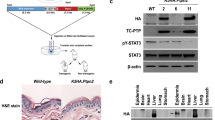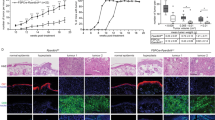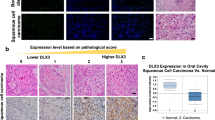Abstract
Tumor progression locus 2 (Tpl2) is a serine/threonine kinase in the mitogen-activated protein kinase signal transduction cascade known to regulate inflammatory pathways. Previously identified as an oncogene, its mutation or overexpression is reported in a variety of human cancers. To address its role in skin carcinogenesis, Tpl2−/− or wild-type (WT) C57BL/6 mice were subjected to a two-stage dimethylbenzanthracene/12-O-tetradecanoylphorbol-13-acetate (TPA) mouse skin carcinogenesis model. Tpl2−/− mice developed a significantly higher incidence of tumors (80%) than WT mice (17%), as well as a reduced tumor latency and a significantly higher number of total tumors (113 vs 6). Moreover, Tpl2−/− mice treated with TPA experienced significantly higher nuclear factor kappaB (NF-κB) activation, edema, infiltrating neutrophils and production of proinflammatory cytokines than did WT mice. We investigated the role of the p38, JNK, MEK and NF-κB signaling pathways both in vitro and in vivo in WT and Tpl2−/− mice by using inhibitors for each of these pathways. We confirmed that the proinflammatory effect in Tpl2−/− mice was due to heightened activity of the NF-κB pathway. These studies indicate that Tpl2 may serve more as a tumor suppressor than as an oncogene in chemically induced skin carcinogenesis, with its absence contributing to both tumorigenesis and inflammation.
This is a preview of subscription content, access via your institution
Access options
Subscribe to this journal
Receive 50 print issues and online access
$259.00 per year
only $5.18 per issue
Buy this article
- Purchase on Springer Link
- Instant access to full article PDF
Prices may be subject to local taxes which are calculated during checkout





Similar content being viewed by others
References
Aoki M, Akiyama T, Miyoshi J, Toyoshima K . (1991). Identification and characterization of protein products of the cot oncogene with serine kinase activity. Oncogene 6: 1515–1519.
Beinke S, Deka J, Lang V, Belich MP, Walker PA, Howell S et al. (2003). NF-kappaB1 p105 negatively regulates TPL-2 MEK kinase activity. Mol Cell Biol 23: 4739–4752.
Beinke S, Robinson MJ, Hugunin M, Ley SC . (2004). Lipopolysaccharide activation of the TPL-2/MEK/extracellular signal-regulated kinase mitogen-activated protein kinase cascade is regulated by IkappaB kinase-induced proteolysis of NF-kappaB1 p105. Mol Cell Biol 24: 9658–9667.
Belich MP, Salmerón A, Johnston LH, Ley SC . (1999). TPL-2 kinase regulates the proteolysis of the NF-kappaB-inhibitory protein NF-kappaB1 p105. Nature 397: 363–368.
Brunda MJ, Luistro L, Warrier RR, Wright RB, Hubbard BR, Murphy M et al. (1993). Antitumor and antimetastatic activity of interleukin 12 against murine tumors. J Exp Med 178: 1223–1230.
Cataisson C, Pearson AJ, Torgerson S, Nedospasov SA, Yuspa SH . (2005). Protein kinase C alpha-mediated chemotaxis of neutrophils requires NF-kappa B activity but is independent of TNF alpha signaling in mouse skin in vivo. J Immunol 174: 1686–1692.
Ceci JD, Patriotis CP, Tsatsanis C, Makris AM, Kovatch R, Swing DA et al. (1997). Tpl-2 is an oncogenic kinase that is activated by carboxy-terminal truncation. Genes Dev 11: 688–700.
Clark AM, Reynolds SH, Anderson M, Wiest JS . (2004). Mutational activation of the MAP3K8 protooncogene in lung cancer. Genes Chromosomes Cancer 41: 99–108.
Chiariello M, Marinissen MJ, Gutkind JS . (2000). Multiple mitogen-activated protein kinase signaling pathways connect the Cot oncoprotein to the c-jun promoter and to cellular transformation. Mol Cell Biol 20: 1747–1758.
Colombo MP, Vagliani M, Spreafico F, Parenza M, Chiodoni C, Melani C et al. (1996). Amount of interleukin 12 available at the tumor site is critical for tumor regression. Cancer Res. 56: 2531–2534.
Coussens LM, Werb Z . (2002). Inflammation and cancer. Nature 420: 860–867.
de Visser KE, Eichten A, Coussens LM . (2006). Paradoxical roles of the immune system during cancer development. Nat Rev Cancer 6: 24–37.
DiGiovanni J, Prichett WP, Decina PC, Diamond L . (1984). DBA/2 mice are as sensitive as SENCAR mice to skin tumor promotion by 12-O-tetradecanoylphorbol-13-acetate. Carcinogenesis 5: 1493–1498.
Dumitru CD, Ceci JD, Tsatsanis C, Kontoyiannis D, Stamatakis K, Lin JH et al. (2000). TNF-alpha induction by LPS is regulated posttranscriptionally via a Tpl2/ERK-dependent pathway. Cell 103: 1071–1083.
Glick A, Ryscavage A, Perez-Lorenzo R, Hennings H, Yuspa S, Darwiche N . (2007). The high-risk benign tumor: evidence from the two-stage skin cancer model and relevance for human cancer. Mol Carcinog 46: 605–610.
Griner EM, Kazanietz MG . (2007). Protein kinase C and other diacylglycerol effectors in cancer. Nat Rev Cancer 7: 281–294.
Hu Y, Green N, Gavrin LK, Janz K, Kaila N, Li HQ et al. (2006). Inhibition of Tpl2 kinase and TNFalpha production with quinoline-3-carbonitriles for the treatment of rheumatoid arthritis. Bioorg Med Chem Lett 16: 6067–6072.
Jansen AP, Verwiebe EG, Dreckschmidt NE, Wheeler DL, Oberley TD, Verma AK . (2001). Protein kinase C-epsilon transgenic mice: a unique model for metastatic squamous cell carcinoma. Cancer Res 61: 808–812.
Jemal A, Siegel R, Ward E, Hao Y, Xu J, Thun MJ . (2009). Cancer Statistics 2008. CA Cancer J Clin 59: 225–249.
Kane LP, Mollenauer MN, Xu Z, Turck CW, Weiss A . (2002). Akt-dependent phosphorylation specifically regulates Cot induction of NF-kappa B-dependent transcription. Mol Cell Biol 22: 5962–5974.
Karin M . (2006). Nuclear factor-kappaB in cancer development and progression. Nature 441: 431–436.
Kimura YN, Watari K, Fotovati A, Hosoi F, Yasumoto K, Izumi H et al. (2007). Inflammatory stimuli from macrophages and cancer cells synergistically promote tumor growth and angiogenesis. Canc Sci 98: 2009–2018.
Lichti U, Anders J, Yuspa SH . (2008). Isolation and short-term culture of primary keratinocytes, hair follicle populations and dermal cells from newborn mice and keratinocytes from adult mice for in vitro analysis and for grafting to immunodeficient mice. Nat Protoc 3: 799–810.
Moore RJ, Owens DM, Stamp G, Arnott C, Burke F, East N et al. (1999). Mice deficient in tumor necrosis factor-alpha are resistant to skin carcinogenesis. Nat Med 5: 828–831.
Mueller MM . (2006). Inflammation in epithelial skin tumours: old stories and new ideas. Eur J Cancer 42: 735–744.
Patriotis C, Makris A, Bear SE, Tsichlis PN . (1993). Tumor progression locus 2 (Tpl-2) encodes a protein kinase involved in the progression of rodent T-cell lymphomas and in T-cell activation. Proc Natl Acad Sci USA 90: 2251–2255.
Patriotis C, Makris A, Chernoff J, Tsichlis PN . (1994). Tpl-2 acts in concert with Ras and Raf-1 to activate mitogen-activated protein kinase. Proc Natl Acad Sci USA 91: 9755–9759.
Quintanilla M, Brown K, Ramsden M, Balmain A . (1986). Carcinogen-specific mutation and amplification of Ha-ras during mouse skin carcinogenesis. Nature 322: 78–80.
Reddig PJ, Dreckschmidt NE, Ahrens H, Simsiman R, Tseng CP, Zou J et al. (1999). Transgenic mice overexpressing protein kinase C delta in the epidermis are resistant to skin tumor promotion by 12-O-tetradecanoylphorbol-13-acetate. Cancer Res 59: 5710–5718.
Rijzewijk JJ, van Erp PE, Bauer FW . (1989). Two binding sites for Ki67 related to quiescent and cycling cells in human epidermis. Acta Derm Venereol 69: 512–515.
Salmeron A, Ahmad TB, Carlile GW, Pappin D, Narsimhan RP, Ley SC . (1996). Activation of MEK-1 and SEK-1 by Tpl-2 proto-oncoprotein, a novel MAP kinase kinase kinase. EMBO J 15: 817–826.
Sharma SD, Meeran SM, Katiyar N, Tisdale GB, Yusuf N, Xu H et al. (2009). IL-12 deficiency suppresses 12-O-tetradecanoylphorbol-13-acetate-induced skin tumor development in 7,12-dimethylbenz(a)anthracene-initiated mouse skin through inhibition of inflammation. Carcinogenesis 30: 1970–1977.
Sourvinos G, Tsatsanis C, Spandidos DA . (1999). Overexpression of the Tpl-2/Cot oncogene in human breast cancer. Oncogene 18: 4968–4973.
Sugimoto K, Ohata M, Miyoshi J, Ishizaki H, Tsuboi N, Masuda A et al. (2004). A serine/threonine kinase, Cot/Tpl2, modulates bacterial DNA-induced IL-12 production and Th cell differentiation. J Clin Invest 114: 857–866.
Sur I, Ulvmar M, Toftgård R . (2008). The two-faced NF-kappaB in the skin. Int Rev Immunol 27: 205–223.
Tahara H, Zeh III HJ, Storkus WJ, Pappo I, Watkins SC, Gubler U et al. (1994). Fibroblasts genetically engineered to secrete interleukin 12 can suppress tumor growth and induce antitumor immunity to a murine melanoma in vivo. Cancer Res 54: 182–189.
Tomczak MF, Gadjeva M, Wang YY, Brown K, Maroulakou I, Tsichlis PN et al. (2006). Defective activation of ERK in macrophages lacking the p50/p105 subunit of NF-kappaB is responsible for elevated expression of IL-12 p40 observed after challenge with Helicobacter hepaticus. J Immunol 176: 1244–1251.
Tsatsanis C, Patriotis C, Tsichlis PN . (1998). Tpl-2 induces IL-2 expression in T-cell lines by triggering multiple signaling pathways that activate NFAT and NF-kappaB. Oncogene 17: 2609–2618.
Tsatsanis C, Spandidos DA . (2000). The role of oncogenic kinases in human cancer. Int J Mol Med 5: 583–590.
Tsatsanis C, Vaporidi K, Zacharioudaki V, Androulidaki A, Sykulev Y, Margioris AN et al. (2008). Tpl2 and ERK transduce antiproliferative T cell receptor signals and inhibit transformation of chronically stimulated T cells. Proc Natl Acad Sci USA 105: 2987–2992.
Van Acker GJ, Perides G, Weiss ER, Das S, Tsichlis PN, Steer ML . (2007). Tumor progression locus-2 is a critical regulator of pancreatic and lung inflammation during acute pancreatitis. J Biol Chem 282: 22140–22149.
Velasco-Sampayo A, Alemany S . (2001). p27kip protein levels and E2F activity are targets of Cot kinase during G1 phase progression in T cells. J Immunol 166: 6084–6090.
Watford WT, Hissong BD, Durant LR, Yamane H, Muul LM, Kanno Y et al. (2008). Tpl2 kinase regulates T cell interferon-gamma production and host resistance to Toxoplasma gondii. J Exp Med 205: 2803–2812.
Yuspa SH . (1998). The pathogenesis of squamous cell cancer: lessons learned from studies of skin carcinogenesis. J Dermatol Sci 17: 1–7.
Acknowledgements
We thank Dr Jyotsna Pandey for her assistance with confocal microscopy. This work was supported by the NCI/NIH Intramural Research Program.
Author information
Authors and Affiliations
Corresponding author
Ethics declarations
Competing interests
The authors declare no conflict of interest.
Additional information
Supplementary Information accompanies the paper on the Oncogene website
Rights and permissions
About this article
Cite this article
DeCicco-Skinner, K., Trovato, E., Simmons, J. et al. Loss of tumor progression locus 2 (tpl2) enhances tumorigenesis and inflammation in two-stage skin carcinogenesis. Oncogene 30, 389–397 (2011). https://doi.org/10.1038/onc.2010.447
Received:
Revised:
Accepted:
Published:
Issue Date:
DOI: https://doi.org/10.1038/onc.2010.447
Keywords
This article is cited by
-
Overexpression of TPL2 may be a predictor of good prognosis in patients with breast invasive ductal carcinoma
Scientific Reports (2023)
-
Cell adhesion tunes inflammatory TPL2 kinase signal transduction
Cellular and Molecular Life Sciences (2022)
-
Her2 promotes early dissemination of breast cancer by suppressing the p38 pathway through Skp2-mediated proteasomal degradation of Tpl2
Oncogene (2020)
-
Inhibition of HGF/MET signaling decreases overall tumor burden and blocks malignant conversion in Tpl2-related skin cancer
Oncogenesis (2019)
-
Physical and functional interaction of the TPL2 kinase with nucleophosmin
Oncogene (2015)



